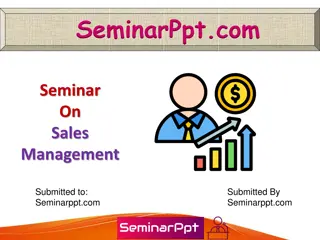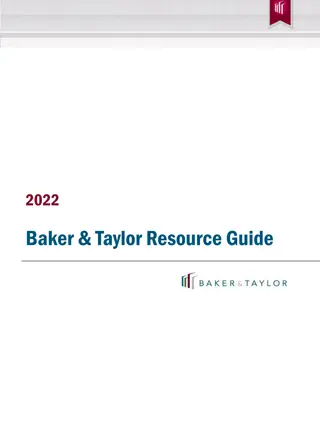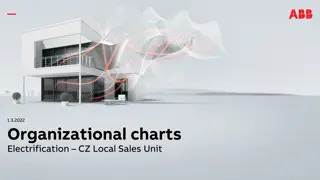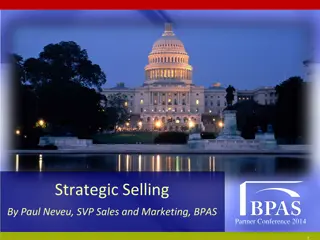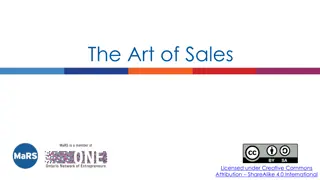Types of Personal Selling and Sales Jobs
In this comprehensive guide, explore the various types of personal selling roles, including trade selling, missionary selling, technical selling, new-business selling, retail selling, and telemarketing. Understand the unique qualities required in a salesperson and the significance of personal selling in developing long-term customer relationships.
Download Presentation

Please find below an Image/Link to download the presentation.
The content on the website is provided AS IS for your information and personal use only. It may not be sold, licensed, or shared on other websites without obtaining consent from the author.If you encounter any issues during the download, it is possible that the publisher has removed the file from their server.
You are allowed to download the files provided on this website for personal or commercial use, subject to the condition that they are used lawfully. All files are the property of their respective owners.
The content on the website is provided AS IS for your information and personal use only. It may not be sold, licensed, or shared on other websites without obtaining consent from the author.
E N D
Presentation Transcript
Marketing I ZAINAB JAFF 2021-2022
Qualities in a Salesperson Liked Disliked Reliability/credibility Professionalism/ integrity Product knowledge Innovation in problem solving Presentation/ preparation Is difficult to communicate with Lacks knowledge of the customer s company Is overly aggressive Makes promises that his or her company cannot deliver
Personal Selling Personal Selling s Unique Role 1. High level of customer attention 4. Communicate more technical and complex information 2. Customize the message 5. Demonstrate a product s functioning and characteristics 6. Develop long-term relationship 3. Yields immediate feedback
Personal Selling Types of Sales Jobs Trade Selling Typically employees of manufacturers Sell through their direct customers Requires limited prospecting and places greater emphasis on servicing accounts Missionary Selling Technical Selling New-business Selling Retail Selling Telemarketing
Personal Selling Types of Sales Jobs Trade Selling Employees of manufacturers Typically pharmaceutical industry Sells for its direct customers (wholesalers) Missionary Selling Technical Selling New-business Selling Retail Selling Telemarketing
Personal Selling Types of Sales Jobs Trade Selling Typically trained in technical fields such as chemistry, engineering, computer science, and accounting Must be able to communicate complicated features to prospective customers Missionary Selling Technical Selling New-business Selling Retail Selling Telemarketing
Personal Selling Types of Sales Jobs Trade Selling Must continuously call on new accounts Bird-dogging, cold calling Continually work to open new accounts e.g., Office copiers, personal computers, business forms, and personal insurance Missionary Selling Technical Selling New-business Selling Retail Selling Telemarketing
Personal Selling Types of Sales Jobs Trade Selling Customer comes to the salesperson Have considerable product knowledge, strong interpersonal skills, and ability to work with a diversity of customers Missionary Selling Technical Selling New-business Selling Retail Selling Telemarketing
Personal Selling Types of Sales Jobs Trade Selling Is used to support or even replace the sales forces Versatility applies to both consumer-oriented products and business-to- business marketing Not appropriate for all sales organizations Missionary Selling Technical Selling New-business Selling Retail Selling Telemarketing
Personal Selling Salesperson Performance Aptitude Includes interests, intelligence, and personality characteristics Some people better suit to one type of sales job than another All must be customer oriented and empathetic Skill level Motivational level Role perceptions Personal characteristics Adaptability
Personal Selling Salesperson Performance Aptitude Includes selling, interpersonal, and technical skills Companies instill the skills needed for success One of the most important skills Close a sale Getting along with immediate superior Skill level Motivational level Role perceptions Personal characteristics Adaptability
Personal Selling Salesperson Performance Aptitude The amount of time and energy a person is willing to expend performing tasks Reciprocally related to performance People are driven in different ways Skill level Motivational level Role perceptions Personal characteristics Adaptability
Personal Selling Salesperson Performance Aptitude Accurate role perception is crucial Often they face role conflicts that diminish their sales performance Organizational citizenship behaviors (OCBs) Skill level Motivational level Role perceptions Personal characteristics Adaptability
Personal Selling Salesperson Performance Aptitude Age, physical size, appearance, race, gender, etc. It doesn t ensure sales success or failure Successful salespeople are androgyny (possess both male and female traits) Skill level Motivational level Role perceptions Personal characteristics Adaptability
Personal Selling Salesperson Performance Aptitude Ability to adapt to situational circumstances Due in part to personal aptitude but also includes learned skills Absolutely essential for success Skill level Motivational level Role perceptions Personal characteristics Adaptability
Personal Selling Excellence in Selling First Impression Self-esteem Depth of knowledge Extended focus Breadth of knowledge Sense of humor Adaptability Creativity Sensitivity Taking risks Enthusiasm Honesty & ethics
Success Factors for Professional Salespeople The top ten success factors in selling: Listening skills Follow-up skills Ability to adapt sales style from situation to situation Tenacity sticking to the task Organizational skills Verbal communication skills Proficiency in interacting with people at all levels within an organization Demonstrated ability to overcome objections Closing skills Personal planning and time management skills
The First Sales Call and the Sales Presentation Successful salespeople think of the sales presentation and demonstration as the pivotal exchange between seller and buyer in the sequence of exchanges that make up the selling process The approach emphasized in this text is the consultative problem-solving strategy
The Strategic/Consultative Selling Model Evolved in response to: Increased competition More complex products More emphasis on customer needs Long-term relationships
Identifying the Prospect s Problems and Needs Using a consultative, problem-solving approach, the professional salesperson tries to uncover the prospect s perceived problems and needs through skillful questioning and careful listening. Royalty-Free, Digital Vision/Getty Images
Planning the Sales Presentation To prepare for the first sales presentation, salespeople can think of 5 planning stages: 1. Gathering information 2. Identifying the prospect s problems and needs 3. Preparing and presenting the sales proposal 4. Confirming the sale and/or the relationship 5. Ensuring customer satisfaction Chapter Review Question: What are the basic steps in planning the sales presentation?
1. Gathering Information Information gathering must start before customer visit. Customer specific info should be collected before the sales presentation. - Google the Company/ examine the web site - Google the Prospect - LinkedIn: Experience at their current job Experience at their former jobs, Shared connections, Groups, Recent activity - Buyer s Twitter Account - Company s Twitter Account - Company s Press and Media Releases Page - Competitors Press and Media Releases Pages - Financial Statements - Blogs - Facebook
2. Identifying the Prospects Needs Too much talk can be detrimental to the sales process. A chronic complaint is that salespeople talk too much, fail to ask the right questions, and do not really listen to the buyer. Top-performing salespeople understand the need to gather all the relevant information they can about prospects and their perceived problems.
2. Identifying the Prospects Needs First, make sure you re talking to decision-makers (those with authority to buy) or key influencers, so neither party s time is wasted. Next, ask probing questions to encourage prospects to provide information on perceived problems, objectives, financial issues, needs, and personal feelings
3. Preparing and Presenting the Sales Proposal Before making a sales presentation, take the time and effort to prepare yourself to give a superb performance. Thus, remember the following: A. Professional approach to sales presentations B. FAB C. Value-added selling (VAS) Royalty-Free, Digital Vision/Getty Images Royalty-Free, Digital Vision/Getty Images
3. Preparing and Presenting the Sales Proposal A. Professional approach to sales presentations Salespeople should custom-tailor the sales presentation and demonstration to the prospect s specific business situation, needs, and individual communication style. The sales presentation strategy can vary depending on different types of prospects
3. Preparing and Presenting the Sales Proposal B. FAB leads to SELLS F S E L L S Features are the obvious characteristics of the product. Advantages are the performance traits of the product that show how it can be used to help the customer better solve a problem than present products can. Benefitsare what the customer wants from the product. Showthe product s features. Explain its advantages. A Lead into the benefits for the prospect. Letthe prospect talk. B Start a trial close.
3. Preparing and Presenting the Sales Proposal C. Value-added selling (VAS) A comprehensive strategy, VAS focuses on providing customers with extra, or value-added benefits over those offered by competitors VAS shows customers that the extra overall perceived value is greater than that the competitors are offering VAS presentations go beyond the FAB approach to convincingly present and demonstrate the overall added value (benefits) that the customer will receive from purchasing from their company across four categories: 1.Value-added product benefits 2.Value-added relationship benefits 3.Value-added company benefits 4.Value-added salesperson benefits Chapter Review Question: What is the value-added selling approach to sales presentations? Identify and discuss the four value dimensions.

 undefined
undefined








